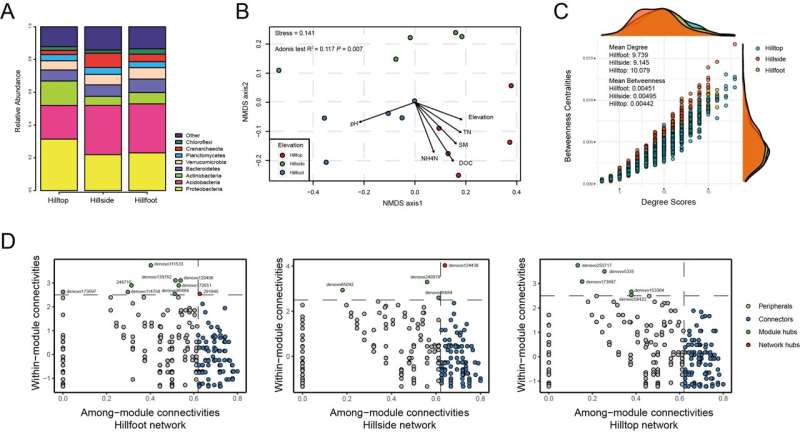Soil pH drives the distribution of soil bacterial communities along a short elevational gradient

Soil microbes are highly diverse and play a key role in the regulation of biogeochemical cycling processes and the maintenance of ecosystem functions. Knowledge of the elevational distribution patterns of soil microbes and the driving mechanisms will be essential to understand the impact of climate change and anthropogenic disturbances on terrestrial ecosystems.This study demonstrates that soil bacterial communities on Zijin Mountain are significantly distinct along a small elevation gradient, and soil pH is the most important driver of the community variation. The researchers' finding appeared December 23, 2021 in Soil Ecology Letters.
A series of studies on the elevational distribution of forest soil microbial communities have been conducted by Haiyan Chu's team at the Institute of Soil Science, Chinese Academy of Sciences, and many interesting findings have been obtained. For example, for the first time they found that soil pH was the key factor driving the vertical distribution of forest soil bacterial communities at a large elevation scale. They also found distinct distribution patterns between soil microbes and plants, suggesting that the body size of individual organisms mainly affects the elevational diversity patterns. However, the patterns in the context of small elevational scales and the driving factors are not well understood.
Professor Chu said, "We chose to study the Zijin Mountain located in Nanjing, which is an urban-park mountain with a large number of visitors coming here for daily recreation. Unlike the previous studies at large elevation scales, the total elevation difference of the sampled sites is only 300 m. Therefore, the Zijin Mountain provides a proper and high-quality platform for microbial distribution studies at small elevation scales."
In this study, they found that Proteobacteria were the dominant phyla in the soils at the top of the mountain, while Acidobacteria prevailed at the foot of the mountain. This finding is closely related to the ecological functions of microorganisms, as Acidobacteria with organic matter degradation functions may prefer acidic habitats at the low elevation where the soil environments are oxygen-enrichment and acidic. Yet, Proteobacteria with multiple ecological processes may be more suitable for high elevation mixed forest zones where soil conditions are complex. In addition, they found that soil pH is the most important driver of soil bacterial distribution along the small elevation gradient. This result suggests the possibility of future fluctuations in soil ecological functions due to soil acidification caused by anthropogenic disturbances or climate change.
"We also used the method of molecular ecological networks to infer the coexistence patterns of soil microbes at the elevational scale and to understand the elevational distribution pattern of soil microbes from the perspective of interspecific interactions," said Professor Chu. Degree scores and Betweenness centralities of soil bacterial communities differ markedly among different elevations, suggesting distinctive biotic interactions. Key species in the co-occurring networks were identified, which provides the further information for managing soil ecological functions through the regulation of key species.
"The study is an extension of our understanding of the vertical distribution of soil microbes from large to small elevation scales, increasing our understanding of the distribution patterns and species coexistence relationships of soil bacterial communities in the context of small elevation scales."
Soil is relevant to our lives; it is fundamental to food security, water security and entire ecosystem health. Monitering and conserving soil biodiversity is more than ever our current missions.
More information: Xu Liu et al, Strong partitioning of soil bacterial community composition and co-occurrence networks along a small-scale elevational gradient on Zijin Mountain, Soil Ecology Letters (2021). DOI: 10.1007/s42832-021-0122-2
Provided by Higher Education Press




















